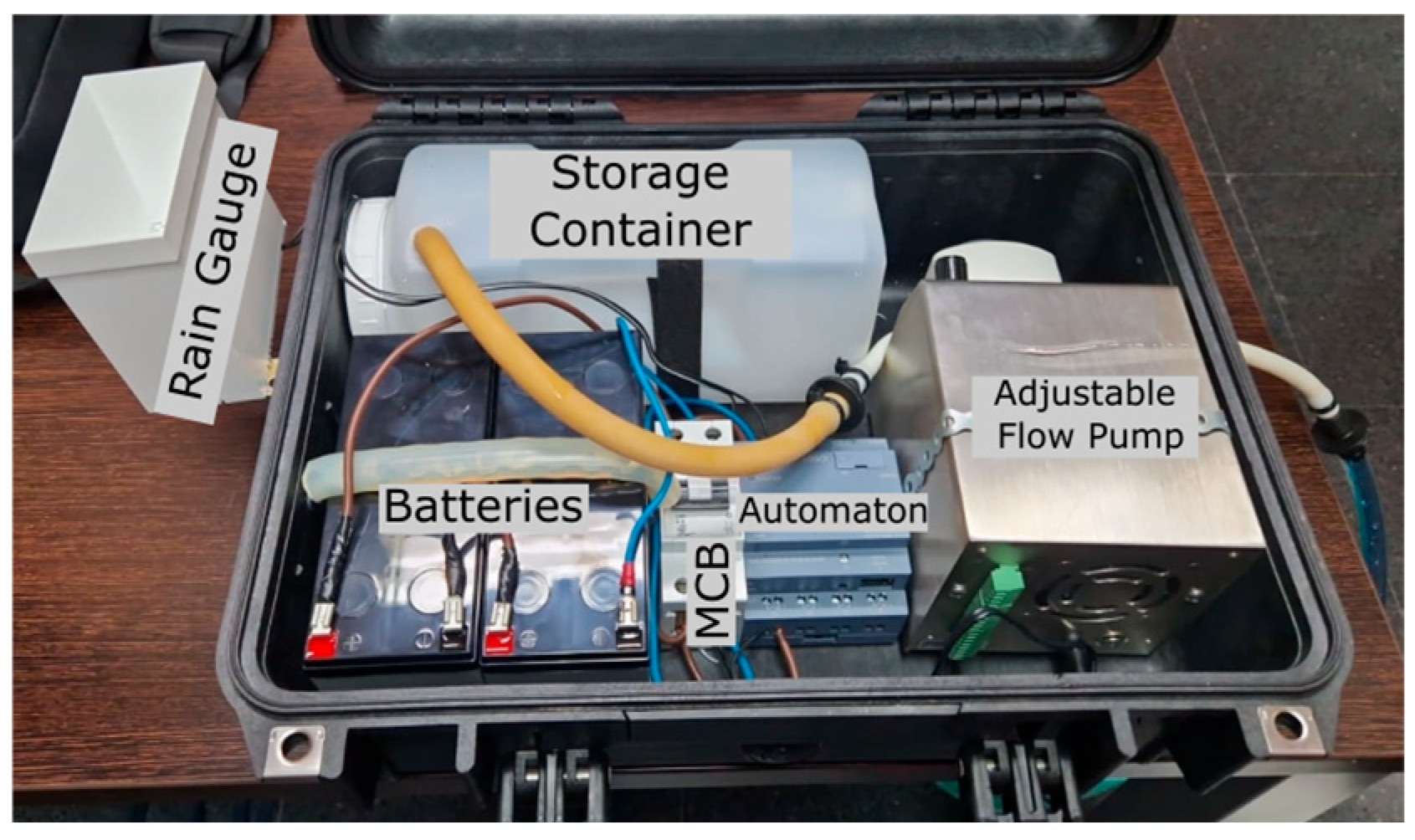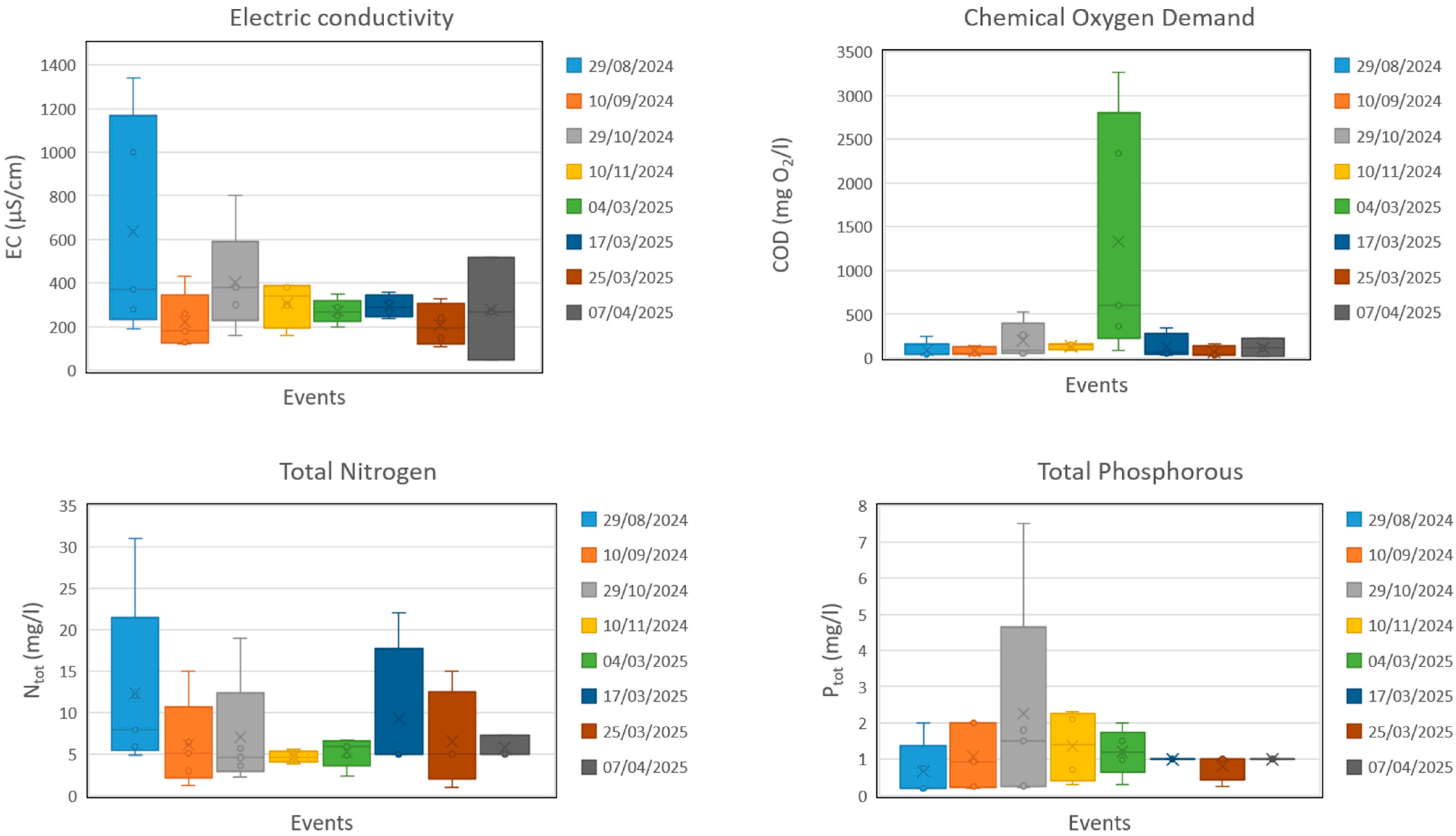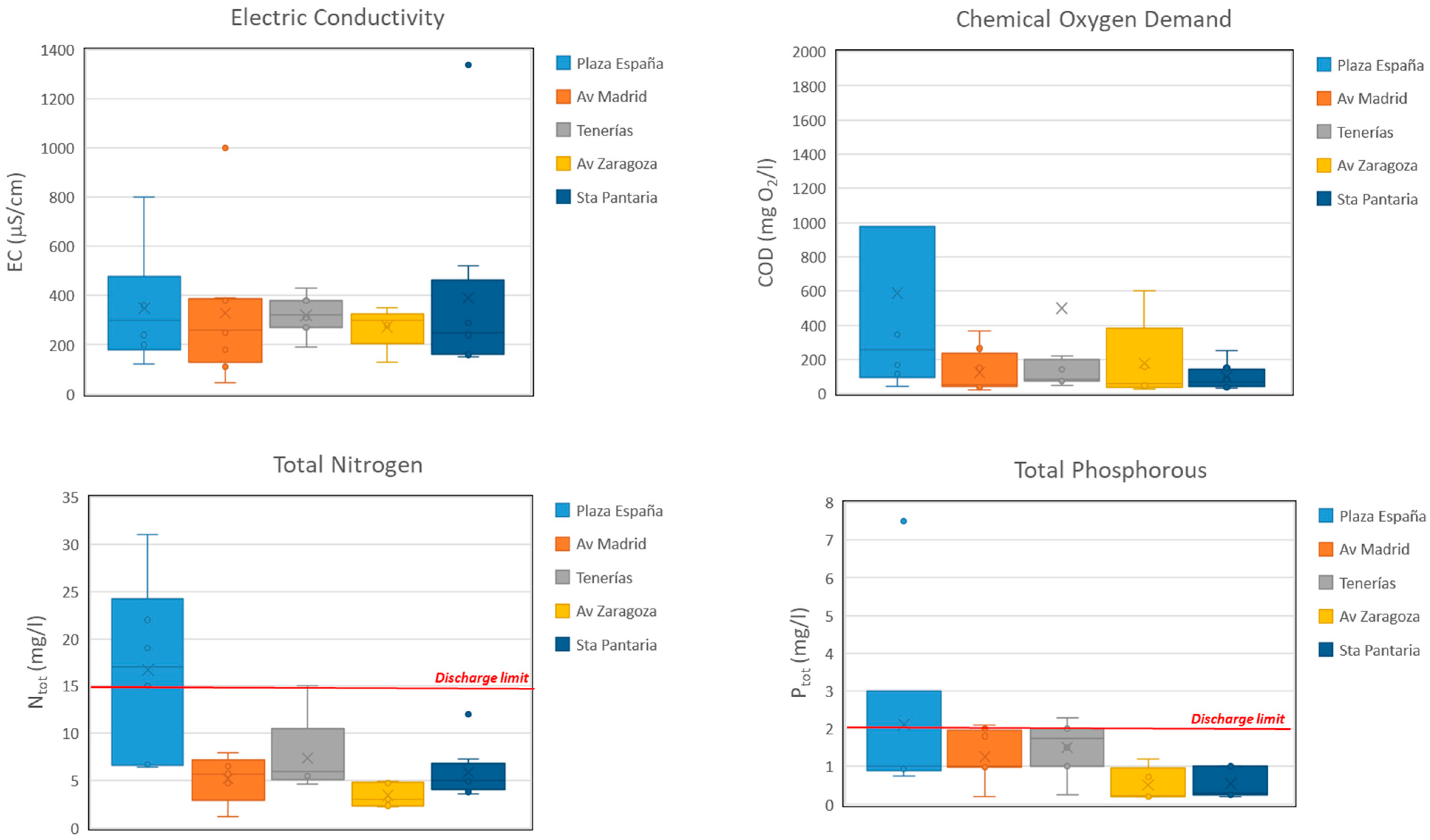Sampling Urban Stormwater: Lessons Learned from a Field Campaign in a Little Town of Spain
Abstract
1. Introduction
2. Materials and Methods
2.1. Sampling Methodology
2.2. Analytical Routine
3. Results
4. Discussion
5. Conclusions
6. Patents
Supplementary Materials
Author Contributions
Funding
Data Availability Statement
Conflicts of Interest
Abbreviations
| WWTP | Wastewater treatment plant |
| CSO | Combine sewer overflow |
| EMC | Event mean concentration |
| EC | Electrical conductivity |
| COD | Chemical oxygen demand |
References
- Popick, H.; Brinkmann, M.; McPhedran, K. Assessment of stormwater discharge contamination and toxicity for a cold-climate urban landscape. Environ. Sci. Eur. 2022, 34, 43. [Google Scholar] [CrossRef] [PubMed]
- Rauch, W.; Ledin, A.; Eriksson, E.; Deletic, A.; Hunt, W.F., III. Stormwater in urban areas. Water Res. 2012, 46, 6588. [Google Scholar] [CrossRef]
- Mayer, T.; Rochfort, Q.; Marsalek, J.; Parrott, J.; Servos, M.; Baker, M.; Mcinnis, R.; Jurkovic, A.; Scott, I. Environmental characterization of surface runoff from three highway sites in Southern Ontario, Canada: 2. Toxicology. Water Qual. Res. J. Can. 2011, 46, 121–136. [Google Scholar] [CrossRef]
- Müller, A.; Österlund, H.; Marsalek, J.; Viklander, M. The pollution conveyed by urban runoff: A review of sources. Sci. Total Environ. 2020, 709, 136125. [Google Scholar] [CrossRef]
- Hall, K.J.; Anderson, B.C. The toxicity and chemical composition of urban stormwater runoff. Can. J. Civil. Eng. 1988, 15, 98–106. [Google Scholar] [CrossRef]
- Järveläinen, J.; Sillanpää, N.; Koivusalo, H. Land-use based stormwater pollutant load estimation and monitoring system design. Urban Water J. 2015, 14, 223–236. [Google Scholar] [CrossRef]
- Potreck, A.; Tränckner, J. Stormwater Pollution of Non-Urban Areas—A Review. Water 2025, 17, 1704. [Google Scholar] [CrossRef]
- Barbosa, A.E.; Fernandes, J.N.; David, L.M. Key issues for sustainable urban stormwater management. Water Res. 2012, 46, 6787–6798. [Google Scholar] [CrossRef]
- Butler, D.; Digman, C.; Makropoulos, C.; Davies, J.W. Urban Drainage, 5th ed.; CRC Press: Boca Raton, FL, USA, 2024; 648p. [Google Scholar] [CrossRef]
- Passerat, J.; Ouattara, N.K.; Mouchel, J.M.; Rocher, V.; Servais, P. Impact of an intense combined sewer overflow event on the microbiological water quality of the Seine River. Water Res. 2011, 45, 893–903. [Google Scholar] [CrossRef]
- Pongmala, K.; Autixier, L.; Madoux-Humery, A.S.; Fuamba, M.; Galarneau, M.; Sauvé, S.; Prévost, M.; Dorner, S. Modelling total suspended solids, E. coli and carbamazepine, a tracer of wastewater contamination from combined sewer overflows. J. Hydrol. 2015, 531, 830–839. [Google Scholar] [CrossRef]
- Locatelli, L.; Russo, B.; Acero, A.; Sánchez, J.C.; Martínez, E.; Martínez, M. Modeling of E. coli distribution for hazard assessment of bathing waters affected by combined sewer overflows. Nat. Hazards Earth Syst. Sci. 2020, 20, 1219–1232. [Google Scholar] [CrossRef]
- Russo, B.; Acero, A.; Arvia, M.; Lopez-Julian, P.L. Estimación de la pérdida de eficiencia hidráulica de imbornales por efecto de la colmatación superficial de sus rejillas. DYNA 2025, 100, 394–397. [Google Scholar] [CrossRef]
- Wilber, W.G.; Hunter, J.V. Aquatic transport of heavy metals in the urban environment. Water Resour. Bull. 1977, 13, 721–734. [Google Scholar] [CrossRef]
- Kaufman, H.L.; Lai, F. Cost effective combined sewer overflow pollution abatement planning. J. Water Pollut. Control Fed. 1980, 52, 2220–2229. [Google Scholar]
- Kim, L.-H.; Kayhanian, M.; Lau, S.-L.; Stenstrom, M.K. A new modelling approach for estimating first flush metal mass loading. Water Sci. Technol. 2005, 51, 159–167. [Google Scholar] [CrossRef]
- Perera, T.; McGree, J.; Egodawatta, P.; Jinadasa, K.B.S.N.; Goonetilleke, A. Catchment based estimation of pollutant event mean concentration (EMC) and implications for first flush assessment. J. Environ. Manag. 2021, 279, 111737. [Google Scholar] [CrossRef] [PubMed]
- Spanish Patent and Trademark Office; Ministry of Industry and Tourism, Spanish Government. Dispositivo Para Toma de Muestras Automatizada en Imbornales. Publication Number ES1314396, 23 May 2025. [Google Scholar]
- U.S. Environmental Protection Agency. Preliminary Data Summary of Urban Stormwater Best Management Practices; EPA 821-R-99-012; U.S. Environmental Protection Agency: Washington, DC, USA, 1999; 216p.
- Zabel, T.; Milne, I.; Mckay, G. Approaches adopted by the European Union and selected Member States for the control of urban pollution. Urban Water 2001, 3, 25–32. [Google Scholar] [CrossRef]
- Pistocchi, A.; Dorati, C.; Grizzetti, B.; Udias, A.; Vigiak, O.; Zanni, M. Water Quality in Europe: Effects of the Urban Wastewater Treatment Directive; JRC Science for Policy Report; Publications Office of the European Union: Luxembourg, 2019; 118p. [Google Scholar] [CrossRef]
- Quaranta, E.; Fuchs, S.; Liefting, H.J.; Schellart, A.; Pisto, A. Costs and benefits of combined sewer overflow management strategies at the European scale. J. Environ. Manag. 2022, 318, 115629. [Google Scholar] [CrossRef] [PubMed]
- Tiefenthaler, L.L.; Eric, D.; Stein, E.D.; Schiff, K.C. Watershed and land use–based sources of trace metals in urban storm water. Environ. Toxicol. Chem. 2008, 27, 277–287. [Google Scholar] [CrossRef]
- Acero-Oliete, A.; Lopez-Julian, P.L.; Russo, B.; Ruiz-Lozano, O. Comparative Efficiency of Two Different Constructed Wetlands for Wastewater Treatment of Small Populations in Mediterranean Continental Climate. Sustainability 2022, 14, 6511. [Google Scholar] [CrossRef]
- Lopez Julian, P.L.; Gisbert Aguilar, J.; Perez Benedicto, J.A.; Salesa Bordonaba, A.; Delgado del Valle, M.; Sanchez Catalan, J.C. Caracterización geoquímica de las sales procedentes de deyecciones de palomas en patrimonio monumental. Iglesia de El Salvador (Úbeda, Jaén). Ge-Conserv. 2018, 1, 27–37. [Google Scholar] [CrossRef]
- Bedient, P.B.; Lambert, J.L.; Springer, N.K. Stormwater pollutant load—Runoff relationships. J. Water Pollut. Control Fed. 1980, 52, 2396–2404. [Google Scholar]
- Szelag, B.; Górski, J.; Bak, L.; Górska, K. The Impact of Precipitation Characteristics on the Washout of Pollutants Based on the Example of an Urban Catchment in Kielce. Water 2021, 13, 3187. [Google Scholar] [CrossRef]
- Sakson, G.; Brzezinska, A.; Zawilski, M. Emission of heavy metals from an urban catchment into receiving water and possibility of its limitation on the example of Lodz city. Environ. Monit. Assess. 2018, 190, 281. [Google Scholar] [CrossRef]




| Date of Sampled Rain Event | Total Daily Precipitation (PD), mm | Antecedent Dry Days (PD < 5 mm) | Samples Collected |
|---|---|---|---|
| 29 August 2024 | 6.8 | 38 | 5 |
| 10 September 2024 | 13.6 | 15 | 5 |
| 29 October 2024 | 11.8 | 19 | 5 |
| 10 November 2024 | 6.5 | 12 | 4 |
| 4 March 2025 | 9.6 | 16 | 5 |
| 17 March 2025 | 8.8 | 13 | 4 |
| 25 March 2025 | 7.6 | 8 | 4 |
| 7 April 2025 | 14.4 | 13 | 3 |
| Location | Date Event | pH | EC (μS/cm) | Turbidity (NTU) | COD (mg O2/L) | N Tot (mg/L) | Nitrate (mg/L) | P Tot (mg/L) | Cu (μg/L) | Zn (μg/L) | Cr Tot (μg/L) |
|---|---|---|---|---|---|---|---|---|---|---|---|
| Plaza España | 29 August 2024 | 7.7 | 370 | 3.0 | 43 | 31.0 | 6.6 | 0.75 | 25.0 | 45.0 | 11.0 |
| Av/Madrid | 7.9 | 1000 | <0.7 | 47 | 7.9 | 22 | <0.2 | 6.5 | 40 | 11 | |
| Tenerías | 7.4 | 190 | 2.2 | 75 | 5.9 | 2.9 | <2 | 8 | 101 | 11 | |
| Av/Zaragoza | 7.7 | 280 | 8.6 | 46 | 4.9 | 2.6 | 0.21 | 117 | 183 | 11 | |
| Sta. Pantaria | 8.0 | 1340 | 6.0 | 252 | 12.0 | <2.2 | <0.2 | 19 | 81.0 | 12 | |
| Plaza España | 10 September 2024 | 7.7 | 120 | 3.0 | 114 | 6.4 | 6.0 | 0.93 | 60.0 | 345.0 | 16.0 |
| Av/Madrid | 8.1 | 180 | 1.6 | 53 | 1.2 | <2.2 | <2 | 17 | 111 | 13 | |
| Tenerías | 8.3 | 430 | 6.8 | 142 | 15.0 | 6.8 | <2 | 70 | 159 | 12 | |
| Av/Zaragoza | 8.0 | 130 | 1.5 | 27 | 3.0 | <2.2 | <0.2 | 39 | 82 | 11 | |
| Sta. Pantaria | 7.7 | 260 | 1.4 | 56 | 5.1 | 4.5 | 0.3 | 21 | 131.0 | 12 | |
| Plaza España | 29 October 2024 | 8.0 | 800 | >10 | 525 | 19.0 | 7.0 | 5.5 | 48.0 | 57.0 | <1 |
| Av/Madrid | 7.9 | 380 | >10 | 264 | 5.7 | <2.2 | 1.8 | 9.8 | 44 | <1 | |
| Tenerías | 8.1 | 380 | >10 | 84 | 4.6 | <2.2 | 1.5 | 7.3 | 35 | <1 | |
| Av/Zaragoza | 8.2 | 300 | 3.8 | 56 | 2.2 | <2.2 | 0.23 | 62 | 39 | <1 | |
| Sta. Pantaria | 7.8 | 160 | 1.9 | 56 | 3.6 | 9.7 | 0.3 | 8.6 | 65.0 | 1 | |
| Av/Madrid | 10 November 2024 | 8.0 | 390 | >10 | 150 | 4.7 | <2.2 | 2.1 | 21 | 132 | 1.6 |
| Tenerías | 8.0 | 380 | >10 | 84 | 5.5 | <2.2 | 2.3 | 15 | 100 | 1.3 | |
| Av/Zaragoza | 8.0 | 300 | >10 | 159 | 4.7 | <2.2 | 0.72 | 223 | 223 | 3.1 | |
| Sta. Pantaria | 7.7 | 160 | 2.9 | 150 | 3.8 | 7.9 | 0.3 | 33 | 244.0 | 4.9 | |
| Plaza España | 4 March 2025 | 7.7 | 200 | >10 | 2340 | 6.7 | 1.1 | 1.5 | 34.0 | <10 | 0.0 |
| Av/Madrid | 7.7 | 250 | >10 | 365 | 6.5 | 1.7 | 0.99 | 56.0 | <10 | 0.0 | |
| Tenerías | 7.4 | 270 | >10 | 3270 | 5.9 | <0.5 | 2 | 92 | <10 | 0.02 | |
| Av/Zaragoza | 7.9 | 350 | >10 | 600 | 2.4 | <0.5 | 1.2 | 71 | <10 | 0.018 | |
| Sta. Pantaria | 7.9 | 290 | >10 | 84 | 4.9 | 1.3 | 0.3 | 33 | <10 | 0.011 | |
| Plaza España | 17 March 2025 | 7.2 | 360 | >10 | 345 | 22.0 | 2.3 | <1 | 115.0 | <10 | 8.3 |
| Av/Madrid | 7.4 | 270 | 7.8 | 50 | <5 | 1.1 | <1 | 38.0 | <10 | 1.7 | |
| Tenerías | 7.2 | 310 | >10 | 75 | <5 | <0.5 | <1 | 86 | <10 | 1.8 | |
| Sta. Pantaria | 7.5 | 240 | 6.4 | 37 | <5 | 1.1 | <1 | 12 | <10 | 2.1 | |
| Plaza España | 25 March 2025 | 7.3 | 240 | >10 | 166 | 15.0 | 2.5 | <1 | 107.0 | <10 | 6.7 |
| Av/Madrid | 7.4 | 110 | 4.5 | 38 | <5 | <0.5 | <1 | 30.0 | <10 | <1 | |
| Tenerías | 7.5 | 330 | 3.9 | 47 | <1 | <0.5 | 0.25 | 40 | <10 | <1 | |
| Sta. Pantaria | 7.1 | 150 | 3.9 | 32 | <5 | <0.5 | <1 | 19 | <10 | 2.1 | |
| Av/Madrid | 7 April 2025 | 7.8 | 47 | 1.9 | 19 | <5 | <0.5 | <1 | 16.0 | <10 | 1.3 |
| Tenerías | 7.7 | 270 | >10 | 221 | <5 | <0.5 | <1 | 28 | <10 | 13 | |
| Sta. Pantaria | 7.5 | 520 | >10 | 113 | 7.3 | <0.5 | <1 | 131 | <10 | 2.8 |
| Parameter | Units | Average Value | Max. Value | Min. Value | Standard Deviation | US-EPA (1999) | Discharge Limit (EC) |
|---|---|---|---|---|---|---|---|
| pH | pH units | 7.72 | 8.3 | 7.1 | 0.30 | ||
| EC | μS/cm | 336 | 1340 | 47 | 253 | ||
| Turbidity | NTU | 3.95 | 8.6 | 1.4 | 2.37 | ||
| COD | mg O2/L | 291 | 3270 | 19 | 652 | 200–275 | 125 |
| Nitrate | mg/L | 5.12 | 22 | 1.1 | 5.15 | ||
| Total N | mg/L | 8.03 | 31 | 1.2 | 6.85 | 0.4–20 | 15 |
| Total P | mg/L | 1.38 | 7.5 | 0.21 | 1.68 | 0.02–4.3 | 2 |
| Cu | μg/L | 49.1 | 223 | 6.5 | 46.2 | 10–400 | |
| Zn | μg/L | 116.7 | 345 | 35 | 83.2 | 10–2900 | |
| Total Cr | μg/L | 5.92 | 16 | 0.01 | 5.31 |
| Date of Rain Event | COD (mg O2/L) | N Tot (mg/L) | P Tot (mg/L) |
|---|---|---|---|
| 29 August 2024 | 92.6 | 12.34 | 0.672 |
| 10 September 2024 | 78.4 | 6.14 | 1.076 |
| 29 October 2024 | 197 | 7.02 | 1.86 |
| 10 November 2024 | 135.7 | 4.68 | 1.35 |
| 4 March 2025 | 1331.8 | 5.28 | 2.26 |
| 17 March 2025 | 126.7 | 9.25 | 1.00 |
| 25 March 2025 | 70.7 | 6.50 | 0.81 |
| 7 April 2025 | 117.7 | 5.77 | 1.00 |
Disclaimer/Publisher’s Note: The statements, opinions and data contained in all publications are solely those of the individual author(s) and contributor(s) and not of MDPI and/or the editor(s). MDPI and/or the editor(s) disclaim responsibility for any injury to people or property resulting from any ideas, methods, instructions or products referred to in the content. |
© 2025 by the authors. Licensee MDPI, Basel, Switzerland. This article is an open access article distributed under the terms and conditions of the Creative Commons Attribution (CC BY) license (https://creativecommons.org/licenses/by/4.0/).
Share and Cite
Lopez-Julian, P.L.; Acero-Oliete, A.; Antolín Cañada, D.; Borque Horna, C.; Arvia, M.; Russo, B. Sampling Urban Stormwater: Lessons Learned from a Field Campaign in a Little Town of Spain. Water 2025, 17, 3294. https://doi.org/10.3390/w17223294
Lopez-Julian PL, Acero-Oliete A, Antolín Cañada D, Borque Horna C, Arvia M, Russo B. Sampling Urban Stormwater: Lessons Learned from a Field Campaign in a Little Town of Spain. Water. 2025; 17(22):3294. https://doi.org/10.3390/w17223294
Chicago/Turabian StyleLopez-Julian, Pedro Luis, Alejandro Acero-Oliete, Diego Antolín Cañada, Carmelo Borque Horna, Mariarosaria Arvia, and Beniamino Russo. 2025. "Sampling Urban Stormwater: Lessons Learned from a Field Campaign in a Little Town of Spain" Water 17, no. 22: 3294. https://doi.org/10.3390/w17223294
APA StyleLopez-Julian, P. L., Acero-Oliete, A., Antolín Cañada, D., Borque Horna, C., Arvia, M., & Russo, B. (2025). Sampling Urban Stormwater: Lessons Learned from a Field Campaign in a Little Town of Spain. Water, 17(22), 3294. https://doi.org/10.3390/w17223294







